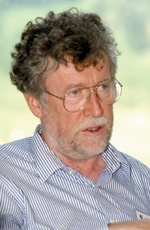Commentary: Albrecht Wagner
 Photo: Reidar Hahn, Fermilab |
The ILC Challenge
To a particle physicist, every particle physics laboratory, anywhere in the world, feels like home. Beyond the familiar presence of accelerators and control rooms, the polyglot chatter in the cafeteria, and the reunions with colleagues, there is something in the atmosphere of a high-energy physics lab that says to a particle physicist Youre home.
And so it was that when 230 high-energy physicists from 15 countries met at KEK, the particle physics laboratory in Tsukuba, Japan, in mid-November 2004, the meeting had something of the air of a family gatheringwith a particular buzz of excitement. The KEK workshop marked the first occasion that the high-energy physics community had come together since the announcement of the superconducting technology choice for an International Linear Collider in August 2004. For the first time, accelerator physicists and engineers from most of the worlds particle physics laboratories had gathered to start on the design for a global accelerator with a single technology. Most of us at the First ILC Workshop had worked for years on either the chosen technology or the alternative.
The [technology] decision was a difficult but necessary one, Maury Tigner had said back in August. It opens the way for the world particle physics community to unite behind one technology and concentrate our combined resources on the design of a superconducting-technology linear collider. Now, at KEK, it was time to put these words into action.
Global projects rely on collaboration. Historically, experimental particle physics has developed an exemplary culture of international collaboration to build and operate experiments. Experimenters have to make these collaborations work, to meet the scientific challenges. But can the collaborative model that has worked so well for experiments become the model for particle accelerators? Can the accelerator builders of the world transcend their varyingsometimes opposingpoints of view to design a global accelerator to address the most compelling scientific questions in the history of the field?
The answer, based on the KEK workshop, is yes. The overwhelming sense was one of excitement about the science, and determination to grasp the unprecedented opportunities presented by the worldwide technology consensus. It was exciting to watch groups of scientists work through their differences to grapple with the difficult issues of who will do what, where, and when, in the enormous task of designing the worlds next particle accelerator.
The process was not without stresses and strains, and it helped to talk about them openly. We were shocked, an Asian colleague frankly told a workshop session, describing KEKs re-action to the August technology decision. But he went on to describe the remarkable progress the laboratory has made in putting its outstanding accelerator physics capabilities to work in a new direction. The First ILC Workshop gave global collaboration crucial forward momentum.
The process of forging a true global ILC collaboration has begun well, but it has only begun. Building an ILC will depend at least as much on developing new forms of scientific cooperation among nations as on developing new technologies. The challenges which lie ahead make me think of John Kennedys words in 1962 about the mission to go to the moon:
We choose to go to the moon in this decade and do the other things, not because they are easy, but because they are hard, because that goal will serve to organize and measure the best of our energies and skills, because that challenge is one that we are willing to accept, one we are unwilling to postpone, and one which we intend to win.
Just as today particle physicists feel at home in each others laboratories, our success in building an International Linear Collider will take us a giant step forward in making the science of particle physics at home in the world.
Albrecht Wagner has been Director General of Deutsches Elektronen-Synchrotron (DESY) since 1999.
Click here to download the pdf version of this article.


